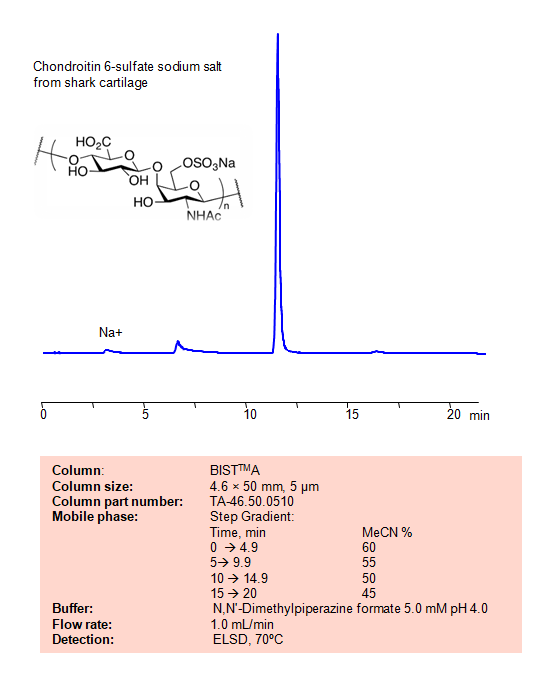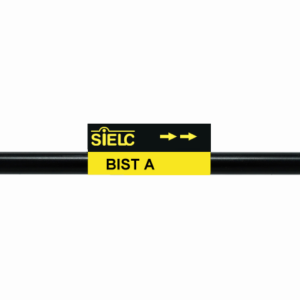High Performance Liquid Chromatography (HPLC) Method for Analysis of Chondroitin Sulfate on BIST A by SIELC Technologies.
Separation type: Bridge Ion Separation Technology, or BIST™ by SIELC Technologies

Chondroitin sulfate is a sulfated glycosaminoglycan (GAG) composed of chains of alternating sugars (N-acetylgalactosamine and glucuronic acid). It is one of the major components of cartilage and is found in various tissues in the body, including the skin, bone, and cornea.
Therapeutic Uses:
- Osteoarthritis: The most common use of chondroitin sulfate is for the treatment of osteoarthritis. It’s often taken in combination with another compound, glucosamine. Studies suggest that chondroitin sulfate can help reduce pain and improve joint function in osteoarthritis patients. However, the extent of its effectiveness is still a topic of debate, with some studies showing significant benefits and others only modest or no benefit.
- Other Potential Uses: While not as extensively researched as its use in osteoarthritis, chondroitin sulfate has also been studied for its potential benefits in other conditions, such as interstitial cystitis and atherosclerosis.
Mechanism of Action: The exact mechanism by which chondroitin sulfate works in osteoarthritis is not entirely understood. It is believed to:
- Provide building blocks for the synthesis of new cartilage.
- Inhibit enzymes that break down cartilage.
- Have anti-inflammatory effects.
Administration and Dosage: Chondroitin sulfate is available in oral tablet or capsule form, often in combination with glucosamine.
Using SIELC’s newly introduced BIST™ method, however, chondroitin sulfate can be retained, analyzed on a negatively-charged, cation-exchange BIST™ A column. There are two keys to this retention method: 1) a multi-charged, positive buffer, such as N,N’-Dimethylpiperazine (DMP), which acts as a bridge, linking the negatively-charged anion analytes to the negatively-charged column surface and 2) a mobile phase consisting mostly of organic solvent (such as MeCN) to minimize the formation of a solvation layer around the charged analytes. Other positively-charged buffers that can generate BIST™ include TMDAP, Calcium acetate, and Magnesium acetate. Using this new and unique analysis method, chondroitin sulfate retained with high selectivity and great peak shape. This method can be detected and is compatible with ELSD, CAD, and Mass Spectrometry (LC-MS).
High Performance Liquid Chromatography (HPLC) Method for Analyses of Chondroitin Sulfate
Condition
| Column | BIST A, 4.6 x 50 mm, 5 µm, 100 A, dual ended |
| Mobile Phase | Step gradient MeCN |
| Buffer | N,N’-Dimethylpiperazine formate 5.0 mM pH 4.0 |
| Flow Rate | 1.0 ml/min |
| Detection | ELSD, the nebulizer and evaporator temperatures 70 °C, with a gas flow rate of 1.6 Standard Liters per Minute (SLM) (MS- compatible mobile phase) |
| Peak Retention Time | 12.37 min |
Description
| Class of Compounds | Glycosaminoglycans (GAGs). |
| Analyzing Compounds | Chondroitin Sulfate |
Application Column
BIST A
Column Diameter: 4.6 mm
Column Length: 50 mm
Particle Size: 5 µm
Pore Size: 100 A
Column options: dual ended





